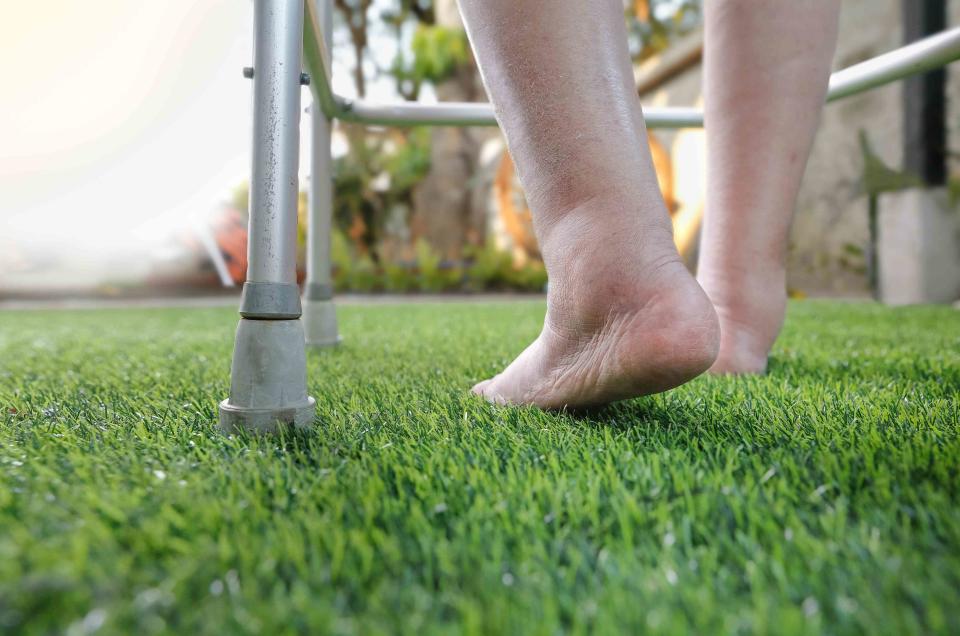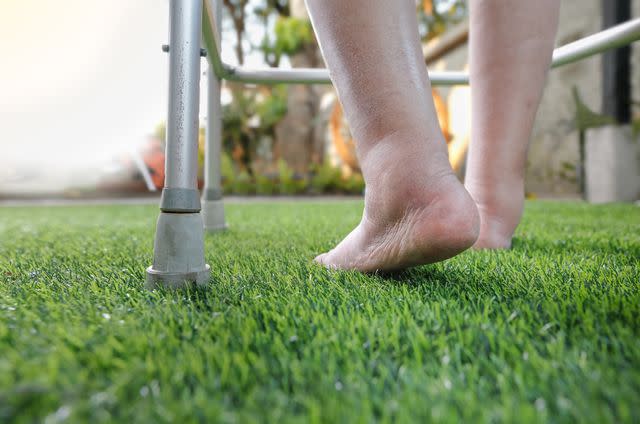Slowing Charcot Foot Neuropathy
Treatment may include surgery and walking devices

Toa55 / Getty Images
Medically reviewed by Danielle McNeil, D.P.M
Charcot foot is a condition that can develop from peripheral neuropathy caused by diabetes. This condition is also called Charcot neuroarthropathy, Charcot arthropathy, or diabetic foot. Charcot foot ranges in severity, and damage can be permanent. Early diagnosis is critical for avoiding surgery, including amputation.
This article discusses how Charcot foot develops and progresses and treatment interventions, including assistive walking devices and footwear.

Toa55 / Getty Images
Why Does Neuropathy Cause Charcot Foot?
Diabetes damages small blood vessels throughout the body, decreasing blood flow to the nerves, which can cause neuropathy.
Neuropathy causes loss of sensation. This means that a person with foot neuropathy can experience an injury or cut their skin and not feel it. Also, a wound can develop, and due to poor blood flow, it doesn't heal well.
Charcot foot deformities can eventually develop from foot injuries, such as a broken or dislocated bone, that go undetected due to neuropathy. Deformities can also result from long-term changes in how a person walks with decreased foot sensation.
Risk factors for Charcot foot include the following:
Age
Duration and type of diabetes
Bone mineral density
Peripheral neuropathy
Arterial disease
History of foot injury (trauma)
What Is a Diabetic Ulcer?
Diabetic ulcers are open wounds or sores that often develop on the feet of people with diabetes. Neuropathy—nerve damage that can occur with diabetes—causes loss of sensation, which increases the risk of undetected injuries.
Charcot Foot Stages
Nearly 13% of people with diabetes will develop Charcot foot. It is common for people with this condition to experience delays in treatment due to a missed diagnosis. One study reports that 79% of people with Charcot foot experience a 29-week delay in treatment due to missed diagnoses.
Healthcare providers diagnose Charcot foot by asking about your medical history, doing a physical exam, and confirming a suspected diagnosis with imaging, such as X-rays or magnetic resonance imaging (MRI).
Charcot foot progresses through the following four stages:
Stage 0: During this stage, the foot is mildly inflamed or swollen, red, and warm. Healthcare providers use X-rays or MRIs to view tiny cracks in the bones (also known as stress fractures) and swelling or bone bruising.
Stage 1: Inflammation is severe in this stage. Bone fractures are visible on X-ray, and joint dislocation and bone swelling are visible on MRI. Deformities begin to form.
Stage 2: During this stage, damaged bones are broken down and dissolved (coalescence). Broken bones begin to heal and fuse, leading to permanent deformities.
Stage 3: Bones are rebuilding, and the foot is deformed. Open wounds (ulcers) are also common at this stage.
Because Charcot foot is caused by nerve damage, it typically is not painful.
When Do You Need Charcot Foot Surgery?
Surgery is required for Charcot foot if the condition can't be managed with assistive walking devices, custom footwear, or casting.
A healthcare provider may recommend one of several types of surgery, including the following:
Wound debridement: If you have ulcers that are not healing properly, you may need surgical debridement (removal of dead tissue).
Removal of pointed bones: Bone changes with Charcot foot can cause parts of the bone to put pressure on the skin, leading to an ulcer if left untreated. A surgeon can remove these bony protrusions.
Muscle or tendon lengthening: Charcot foot can lead to tightness of the calf muscles and Achilles tendon that attaches these muscles to the foot. This tightness can cause pressure points on the foot, leading to ulcers. Lengthening the muscle or tendon can help relieve this pressure.
Correction of deformities: Charcot foot causes deformities, sometimes requiring surgery to hold the bones in place and stabilize the foot for walking.
Amputation: Charcot foot can lead to amputation in the most severe cases. This can occur due to wounds that will not heal, bone infection, loss of blood supply to the foot, and severe deformity.
Charcot Foot Treatment to Help With Mobility
Treatment for Charcot foot involves immobilizing the foot so the bones can heal properly. Healthcare providers usually immobilize the foot with a casting or advise that you wear a medical boot to prevent your ankle and foot from moving.
While your foot is immobilized, you will be instructed not to put any weight on the foot to allow the bones to heal. This process can take several months or more.
After surgery, weight bearing is also restricted for several months while the foot is healing.
Once the bones are healed, orthotics (shoe inserts), braces (such as an ankle-foot orthosis or AFO), or custom shoes might be required to help stabilize the joints and accommodate deformities that have developed.
Assistive Devices for Charcot Foot
Charcot foot makes it difficult to walk. You can use assistive devices such as crutches, a walker or cane, or a knee scooter to move around while your foot is immobilized in a cast or boot. You can also use a wheelchair to go longer distances or if both of your feet are affected.
For additional information, recommendations, and training in using assistive devices, consult a physical therapist.
Summary
Charcot foot is a condition that develops from diabetic neuropathy—nerve damage that causes sensation loss in the feet. It is characterized by swelling, redness, and warmth in the early stages. Over time, it can lead to bone fractures, joint dislocations, and ulcers (open wounds). If left untreated, the foot can become permanently deformed.
Treatment for Charcot foot includes immobilization and using assistive devices to relieve pressure on the foot. Depending on the severity of your condition, a healthcare provider may recommend surgery to clean up wounds, correct deformities, and in severe cases, amputate the foot.

